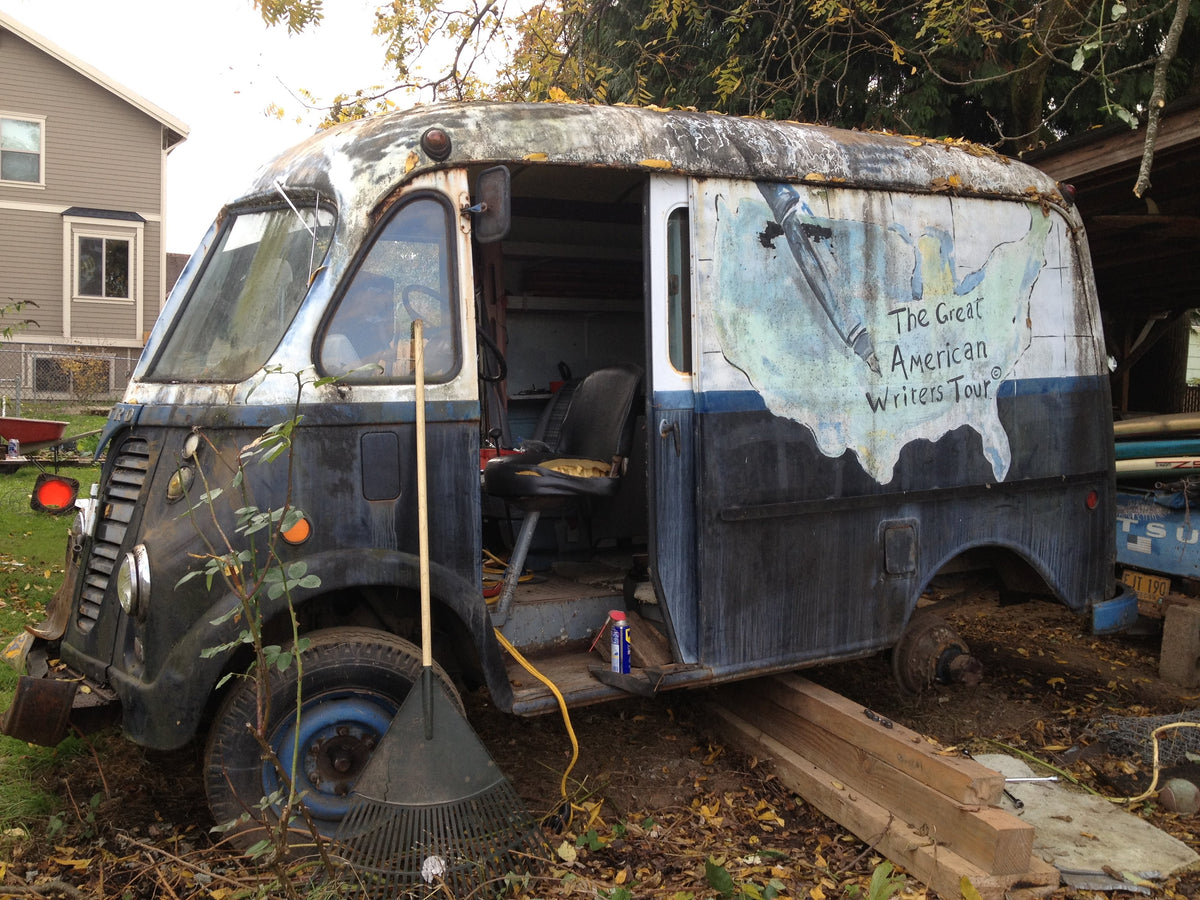In 1996, I spent the month of December selling Christmas trees in Portland, Oregon. Believe it or not, this story is central to how I started RoosRoast Coffee in Ann Arbor, Michigan.
The thing about leaps of faith is that you try something, and maybe it will work and maybe it won’t. Maybe that message doesn’t feel like it would fit for Christmas because so often around the holidays we get stressed out running around fulfilling obligations and expectations. Of all times, Christmas is maybe the least likely time to throw spaghetti at a wall and see what sticks.
At the same time, the “Christmas miracle” is a cliche for a reason - we like to think that in the midst of being locked into obligations and expectations (constructed through some combination of generational wealth and generational trauma) that veering off course can pay off, that unexpected good things can happen. I mean, a whole genre of Hallmark Christmas movies exists just to feed this delusion.
My life as a crêpe chef in a small Mediterranean fishing village near Nice, France was ending...
... as I schemed a best selling idea with friend (and graduate student) Rob Strong. We’d been talking about this idea since meeting at my burrito truck, the Killer Take Out Stand, near Hood River, Oregon. During my French period we’d exchanged letters and drawings, getting excited for an adventure on the road interviewing writers and learning their trade.
In France I spoke French and felt at home in the culture of cafes and color, ideas and style. Sure, I was pillow fighting for my life in that wonderful cafe-crazed society of inspiration and chance, but to be whisked stateside away from the mentally intense life in France was going to heighten my awareness, sharpen my eye, give me something to write about.
Notable characters:
- John Roos the Crêpe Chef at Planet Creperie in France, pre-1996.
2. Poet, writer, friend & fellow G.A.W.T. traveler Robert B. Strong Jr.
At Boulder, Colorado’s Naropa Institute Rob had access to so many writers & was lining up visits across the states.
The title to our unwritten best seller was (G.A.W.T.) The Great American Writers Tour. We would start in Portland, Oregon and end in Portland, Oregon. We had this idea of “Living Fiction” Inspired by the Nike tagline “Just Do it! When asked about our plans, we would say “circumnavigating the United States tracking down writers” like we were going to sail into uncharted territory around the globe. A six week journey of meetings, openings, closings, chitchats, overnights, readings, writings, jazz, coffee, espresso, cocktails, cafes, bars, restaurants, cities, towns, writers, publishers, journalists, tout le monde!
G.A.W.T. transportation: Vannie, a 1957 International Harvester Metro.
- Vannie slightly disheveled after The Great American Writer's Tour.
2. Vannie in snowy modern times, now retired from the coffee delivery life.
This trip was going to require E and O: energy plus optimism, and lots of coffee and reliable transportation.
First, we needed a vehicle. Rob’s previous roommate, Thomas Lauderdale of Pink Martini fame, found us a 29 year old relic from the Cold War. This International Harvester 1957* Metro even had a desk in the back because it was originally set up with a civil-defense radio for monitoring commies back in the day. (* Jack Kerouac’s novel On the Road came out in 1957 - imagine that!) I was all in, spending all my savings from turning out French crepes to buy the van (which is now called Vannie and sits out front of RoosRoast on Rosewood). A whopping $1100.00. Impressive, right?
Hemingway had written about Michigan while in Paris, and in Nice I was dreaming up and drawing our project’s logo - a map of the United States with a giant fountain pen writing the words:
“Great American Writers Tour.”

I immediately painted the logo on both sides of the van, which looked like a 1950s paddy wagon or a French bakery truck. It had tons of style, but so did the logo. Who knew that stating what you’re doing in a large graphic on the side of your vehicle gives you credibility in the USA? Remember that.
The writer's trip was a whole messy adventure - and leap of faith - deserving of its own blog post, so I’ll spare you the details until next time.
Once we finished the writers tour and got back to Portland I was sure I’d have no problem finding a job in my new home.
But late fall in Portland, Oregon was 41 degrees, raining, and help NOT wanted. The problem with Portland, I discovered, is that you had to know someone to get a job. People were skeptical of outsiders, people living on a couch, or anyone who seemed comfortable using the word “traveling” as a verb. But at the same time, there was something about the place that made you want it to love you back.
During Thanksgiving dinner, our friend Sammy mentioned a wholesale Christmas tree farm in Cottage Grove. All you’d have to do is drive a couple hours south to pack Vannie full of trees, find a fenced parking lot, and set up the pretty Noble Firs, Northmans, and spruces with their green and blue hues. You could use the van as a warming hut, and write between sales. The trees would practically sell themselves. And Sammy, who had already invested in the writers tour and put us up, would front me the money to get started. Sammy owned Sammy’s Flowers, a year round outdoor flower shop in front of The Thrift-Way Grocery Store in NW Portland, so her endorsement of this idea seemed like a good sign.
So much like Portland to provide an unexpected opportunity. Wayne, the man behind Little Baja, was not immediately sold on the idea - I annoyed him by interrupting his Dune games every time I stopped by his office/Airstream trailer to see if he’d decide to let me sell trees or not.
For me it was a no brainer. An outdoor, fenced in business selling Mexican terracotta planters and chimney, ceramic fireplaces, and bird baths? Definitely room for seasonal sales growth through Christmas trees. I wore Wayne down, and soon I had a spot on Burnside in NE Portland to sell!
Here I was, in the city of rain where the air smelled of roasting coffee and that steamy yeasty hoppy aroma of beer brewing.
Painting banners, putting up flyers, I was suddenly self-employed selling trees. Morning started with layers of clothes and yellow tape measure suspenders holding up khaki pants, a long Santa hat, and fresh roast double espresso long pulls from one of the many cafes I’d pass on the way to the lot. Each afternoon ended with an equal number of microbrewed pints, all within walking distance of my new life. For the time in between, all I could see was Christmas Trees.
It turns out that in the city, people don’t shop for their Christmas trees like they do weekly groceries. Place and tradition matter, and being the new Christmas tree lot on the block is a tough sell in a pre-Google pre-social media world. (Remember, it’s 1996!) I talked to everyone I could find about buying trees. Sold a tree to Carla, three to Tyleen, Butch, Brian, and Sherrily. Disheveled nerdishness.
The best Christmas tree customers were those fanatics who bought three trees. One large one well in advance which dries up, loses needles, needs replacing and becomes a fire hazard by the 15th. At which time they return and buy a Noble Fir and why not a small one for the kids? Portland was basically the spirit of Christmas.
When I wasn’t selling trees I’d drive by Jim’s lot on 61st and Halsey just to see how he was doing.
Jim’s Christmas tree selling operation dwarfed mine - he probably sold thousands of trees in a season, enough so that by December 17 he’d had enough and gifted me his last 20 trees. As I drove Vannie over to pick them up, I was definitely expecting some castaway trees right out of a Charlie Brown Christmas.
I knew from Christmas tree seller lore that once we hit December 24, you couldn’t even sell a tree on a Hallmark movie that depended on that sale to save the family farm from an EVIL CORPORATION. (OK yes, this is still not that story, carry on.) On Christmas Eve, in Portland and elsewhere, people who celebrate Christmas are out and about actually celebrating - or frantically buying last minute gifts. It’s a case where the people are just not going to come to the trees: if you’re looking to unload a bunch of trees - if not to make any money doing it - you have to bring the trees to the people.
Did I get rich selling Christmas trees in Portland (or interviewing writers, for that matter)?
Nope. But did I (or Sammy) lose money? Also no. Did it still take me six months to find a new job after the calendar turned to 1997? Yes, yes it did. But I met tons of people, drank good solid Portland coffee (and beer), and learned how retail worked one tree at a time. And Vannie was a great warming hut, and she could fit SO MANY TREES! About 25 at a time at max. (I told you you’d learn something new from making your way through this story.) And that was more than the number Vannie held as I spent my Christmas Eve driving around giving my Land of Misfit Toys leftover trees to the people of Portland.
Because that’s what people who take leaps of faith do, we make something out of nothing and hope that there’s something interesting or fun - or people just looking to connect - on the other side.









